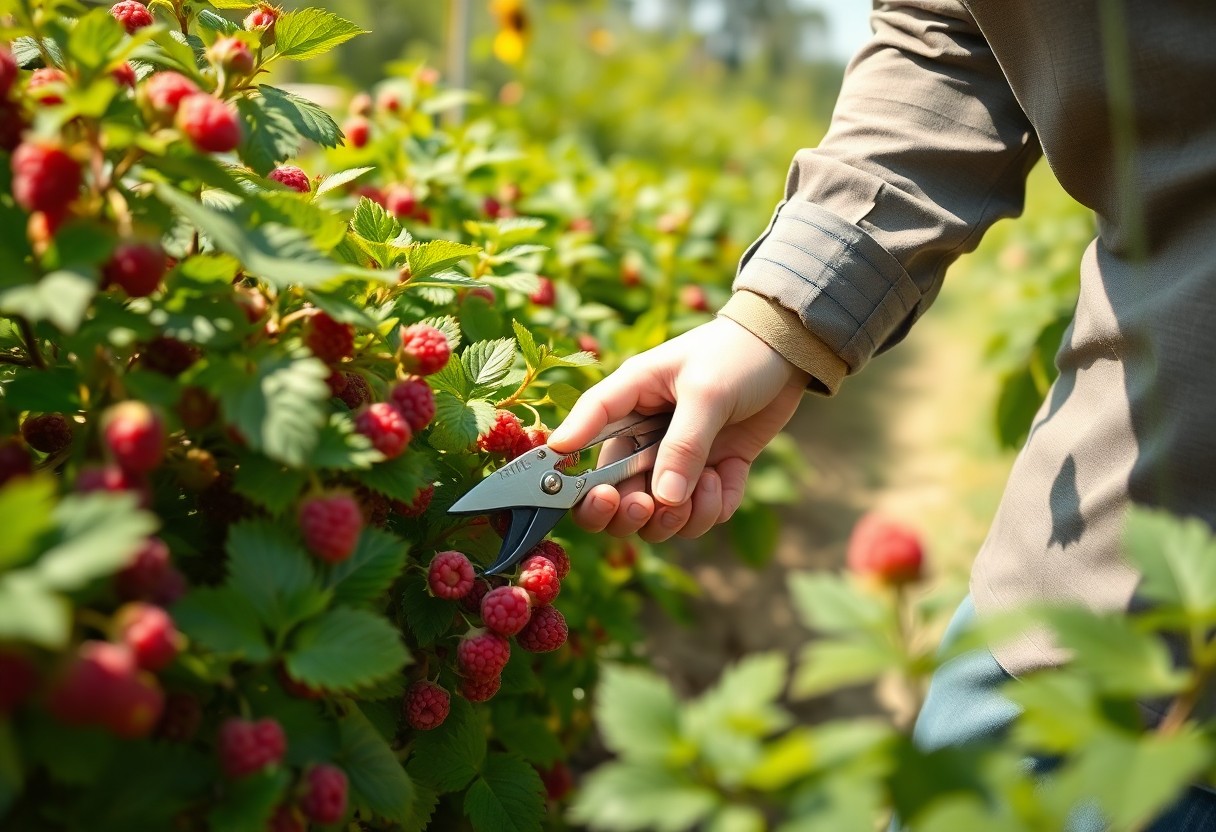
There’s something deeply satisfying about growing your own raspberries, and proper pruning is key to producing a bountiful crop. In this guide, you’ll learn the simple techniques to prune your raspberry bushes, encouraging healthy growth and maximizing your harvest. Whether you’re a seasoned gardener or just starting out, these tips will help you maintain vibrant plants and enjoy delicious berries all season long. Let’s dive in and get your raspberry plants in tip-top shape!
Understanding Raspberry Varieties
Before you probe pruning your raspberries, it’s vital to know the different varieties you might be growing. Raspberries generally fall into two categories: summer-bearing and everbearing. Understanding these types will guide your pruning decisions and help you maximize your harvest.
Summer-Bearing Raspberries
There’s something special about summer-bearing raspberries as they produce a single, abundant crop each summer. Typically, these varieties bear fruit on canes that grew the previous year, so pruning them correctly will ensure a healthy yield for the next season.
Everbearing Raspberries
With everbearing raspberries, you’re in for a treat because they can produce fruit in both summer and fall. These varieties bear fruit on both the previous year’s canes and new growth, allowing you to enjoy their delicious berries for an extended period.
Varieties such as ‘Heritage’ and ‘Josephine’ are popular examples of everbearing raspberries. To get the best from these plants, you can choose to prune them for a larger summer crop or leave them unpruned for a continuous harvest throughout the season. Knowing how to manage your pruning will help you enjoy bountiful harvests from your everbearing raspberries!
When to Prune
Assuming you want your raspberry plants to thrive, timing is everything when it comes to pruning. It’s crucial to identify the right periods for pruning to ensure you maximize fruit yield and overall plant health. For summer-bearing and everbearing varieties, the timing will differ, so pay close attention to your specific type for optimal results.
Timing for Summer-Bearing
One effective approach is to prune summer-bearing raspberries right after harvest. This usually means trimming them back in late summer or early fall. By doing this, you will remove the old canes that have already produced fruit, allowing new growth to flourish in the next season.
Timing for Everbearing
To keep your everbearing raspberries healthy and productive, prune them twice a year. First, you can trim them back in late winter or early spring before new growth starts, removing any weak or dead canes. Then again, after the first crop in late summer, cut back the canes that bore fruit to encourage new growth for a second harvest.
With this two-step pruning process, your everbearing raspberries will have the best chance to produce an abundance of fruit. The late winter or early spring cut will promote robust new growth, while the late summer pruning will allow your plants to focus their energy on developing fresh canes, leading to a healthy harvest all season long.
Essential Pruning Tools
If you want to prune your raspberries effectively, having the right tools is crucial. The right equipment will make the process smoother and more efficient, allowing you to tackle your raspberry bushes with confidence. With just a few simple tools, you can keep your plants healthy and productive while enjoying the satisfaction of a well-pruned garden.
Pruners and Shears
Little secateurs or pruners are must-haves for any raspberry pruning job. These compact tools allow you to make precise cuts on canes and branches, ensuring your plants thrive. You can also opt for larger shears for thicker stems, giving you the versatility needed for different tasks. Invest in a sturdy pair that feels comfortable in your hand to enjoy pruning season after season.
Safety Gear
Even if pruning seems straightforward, it’s wise to put on some safety gear to protect yourself during the task. Sturdy gloves and eye protection will keep your hands safe from thorns and debris, ensuring that your pruning experience is both enjoyable and injury-free.
The right safety gear not only protects you from accidental scrapes and cuts but also makes the job more comfortable. A pair of durable gloves will provide grip while shielding your hands from prickly raspberry canes. Meanwhile, safety goggles prevent any debris from getting into your eyes, allowing you to focus on your pruning without worrying about potential injury. Prioritizing safety means you can prune your raspberries with peace of mind and maximize the enjoyment of your gardening hobby.
How to Prune Raspberries
Many gardeners find that proper pruning is vital to maximize raspberry production. Pruning not only keeps the plants healthy but also helps improve the quality and size of your berries. With the right techniques, you can ensure a bountiful harvest while maintaining an organized and attractive garden space.
Step-by-Step Guide for Summer-Bearing
Little adjustments can lead to big improvements in your summer-bearing raspberry plants. Follow these steps for effective pruning:
| Step | Action |
|---|---|
| 1 | In late winter, cut back last year’s canes to ground level. |
| 2 | Remove any dead or weak canes during this process. |
| 3 | Thin out the remaining healthy canes to about 6-8 per plant. |
Step-by-Step Guide for Everbearing
To keep your everbearing raspberries thriving and productive, use this simple pruning guide:
| Step | Action |
|---|---|
| 1 | In late winter, cut all canes down to about 4-6 inches above the ground. |
| 2 | Remove any weak or dead canes. |
| 3 | After harvest, you can also prune back canes that have already fruited. |
Guide your everbearing raspberry plants towards better yields with this ongoing care. When you prune after the fall harvest, focus on removing the fruiting canes while keeping strong new ones that will produce the next season. This method promotes healthy growth and ensures your plants are productive year after year!
| Step | Action |
|---|---|
| 1 | Remove spent canes in late winter. |
| 2 | Monitor remaining canes through the growing season. |
| 3 | Apply mulch to protect the roots. |
Tips for Healthy Growth
For the best results in your raspberry garden, follow these guidelines to ensure healthy growth:
- Ensure adequate sunlight, aiming for at least 6-8 hours daily.
- Water your plants regularly, especially during dry spells.
- Use mulch to retain soil moisture and suppress weeds.
- Monitor for pests and diseases early to take action.
Perceiving these tips as part of your routine will maximize your raspberry yield and health.
Nutrient Considerations
Healthy raspberries thrive when your soil is rich in nutrients. Regularly amend your soil with organic matter, such as compost or well-rotted manure, to enhance fertility. Also, consider a balanced fertilizer during the growing season to support vigorous growth and fruit production. Pay attention to your plants’ needs, adjusting based on their appearance and performance.
Age of Plants
Little attention is needed for young raspberry plants when it comes to extensive pruning. They require minimal intervention during their initial growth phase to establish strong root systems. As your plants mature, they will benefit from the proper pruning techniques tailored to their age.
This approach is important because younger plants need time to grow and develop before undergoing rigorous pruning. Generally, it’s best to wait until your raspberries are well-established—typically 1-2 years—before starting more detailed pruning techniques. As your plants mature, you’ll notice signs that guide you on how to maintain their health and productivity through pruning. Understanding the age of your plants will help you take the right steps at the right time for a bountiful harvest.
Common Mistakes to Avoid
Once again, pruning can be tricky, and there are a few common mistakes you’ll want to sidestep. One of the biggest pitfalls is pruning at the wrong time, which can hinder your raspberry plants’ growth and fruit production. Another mistake is failing to sterilize your tools, potentially introducing disease into your garden. Lastly, don’t forget to take a close look at the variety of raspberries you’re growing, as each type has its own specific pruning needs!
Over-Pruning
While it may be tempting to cut your raspberry canes back aggressively, over-pruning can lead to reduced yields. You might think that cutting more will lead to healthier plants, but raspberries thrive best when you prune selectively, allowing some canes to remain for future fruit production.
Ignoring Seasonal Changes
Mistakes can happen when you overlook the seasonal changes that affect your raspberries. Each season impacts the growth cycle of your plants, so understanding when they bear fruit is necessary. If you prune too late in the fall or too early in the spring, you might cut off the new growth needed for a bountiful harvest. Timing your pruning according to the seasonal patterns of your specific raspberry variety will ensure that you maintain healthy plants and maximize your fruit production.
With a keen eye on the seasonal shifts, you can plan your pruning schedule effectively. For instance, summer-bearing raspberries should be pruned immediately after fruiting, while fall-bearing varieties benefit from pruning in late winter. Keeping this in mind will help you avoid cutting away potential growth that could produce delicious berries in the coming months.
Final Words
Summing up, pruning your raspberries is a rewarding task that enhances growth and fruit production. By regularly trimming the canes, you promote healthier plants and ensure a bountiful harvest. Be sure to identify which type of raspberries you have, as each variety requires different pruning techniques. Enjoy the process and your beautiful, fruitful raspberry patch will thank you with an abundant crop!







